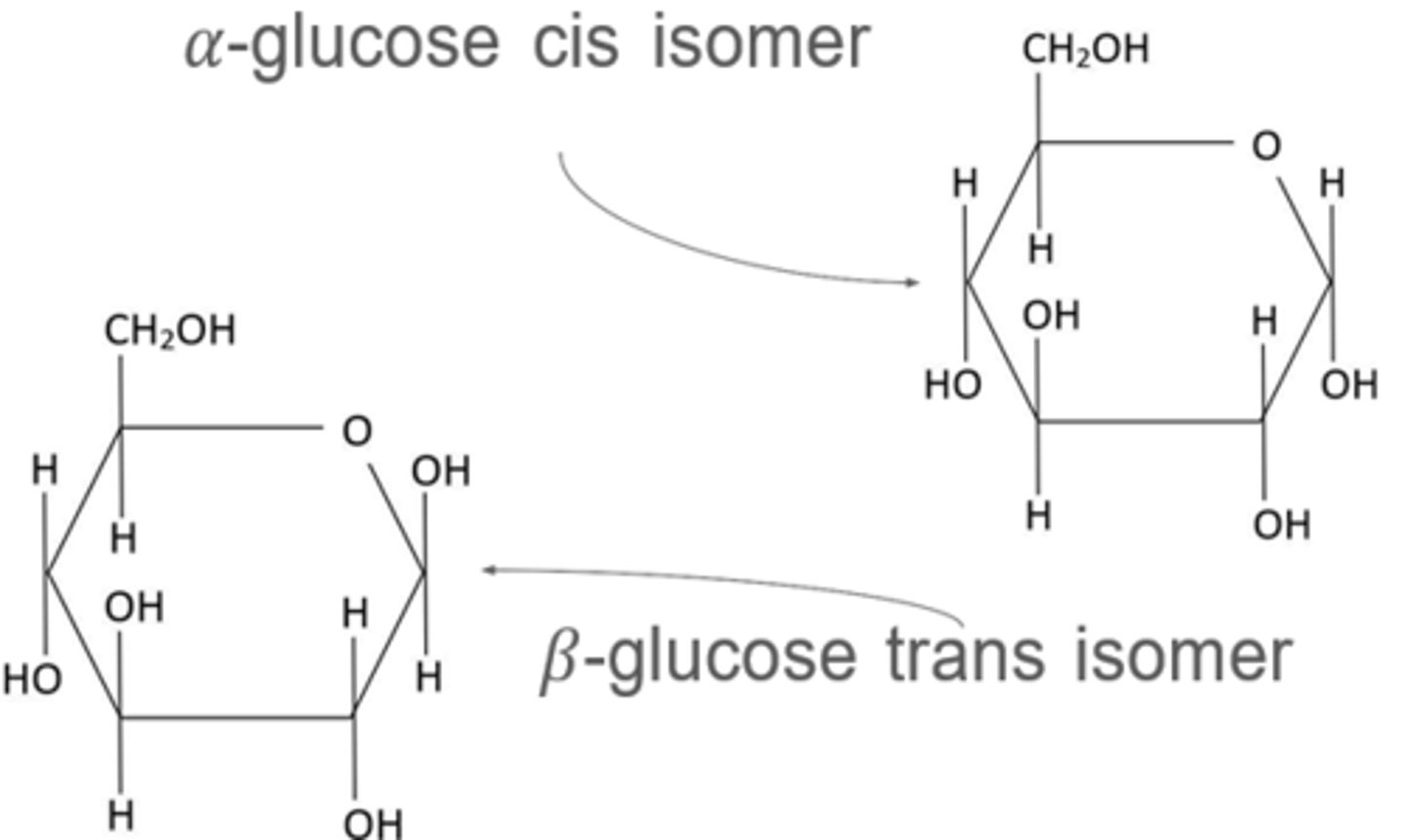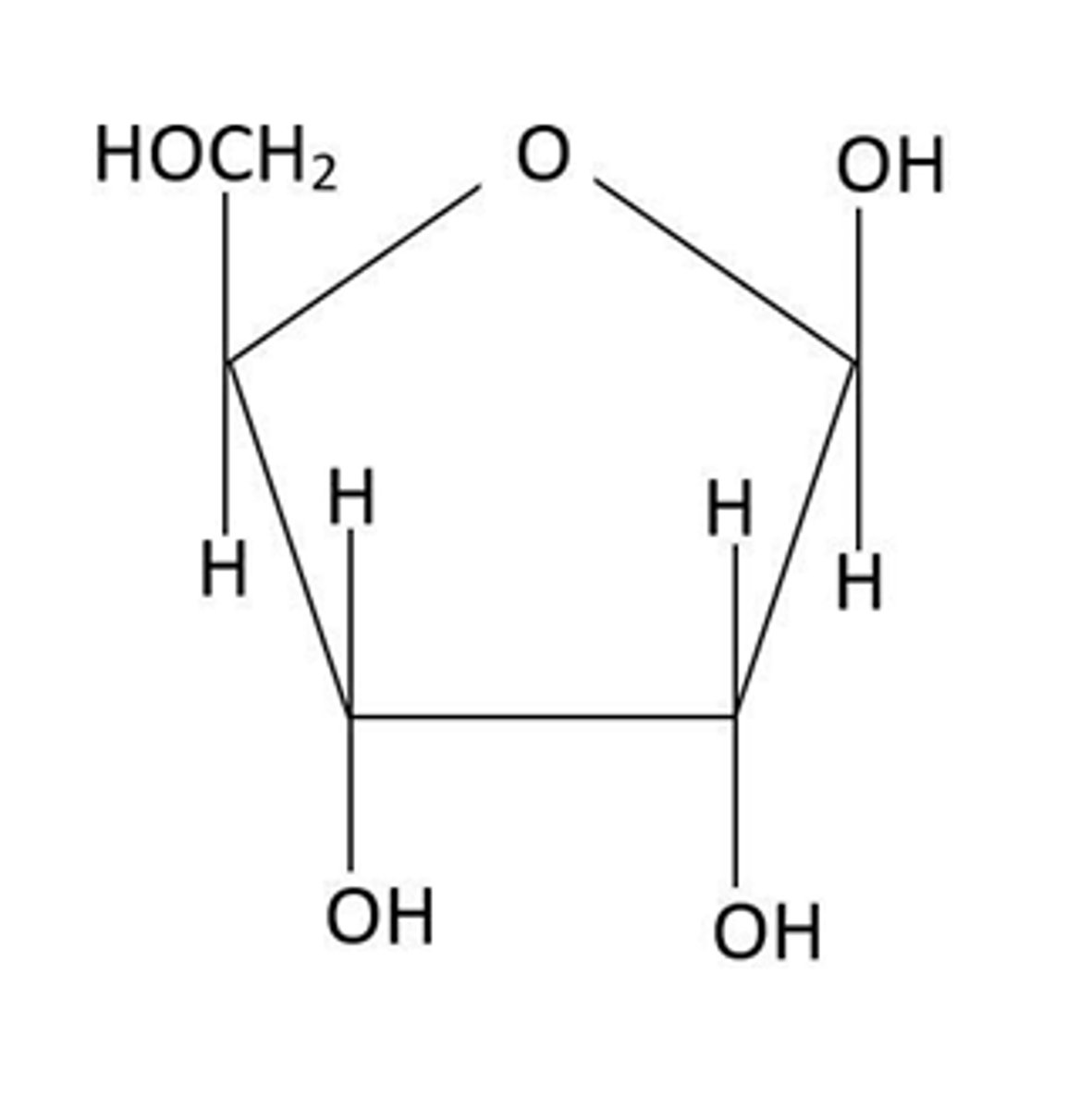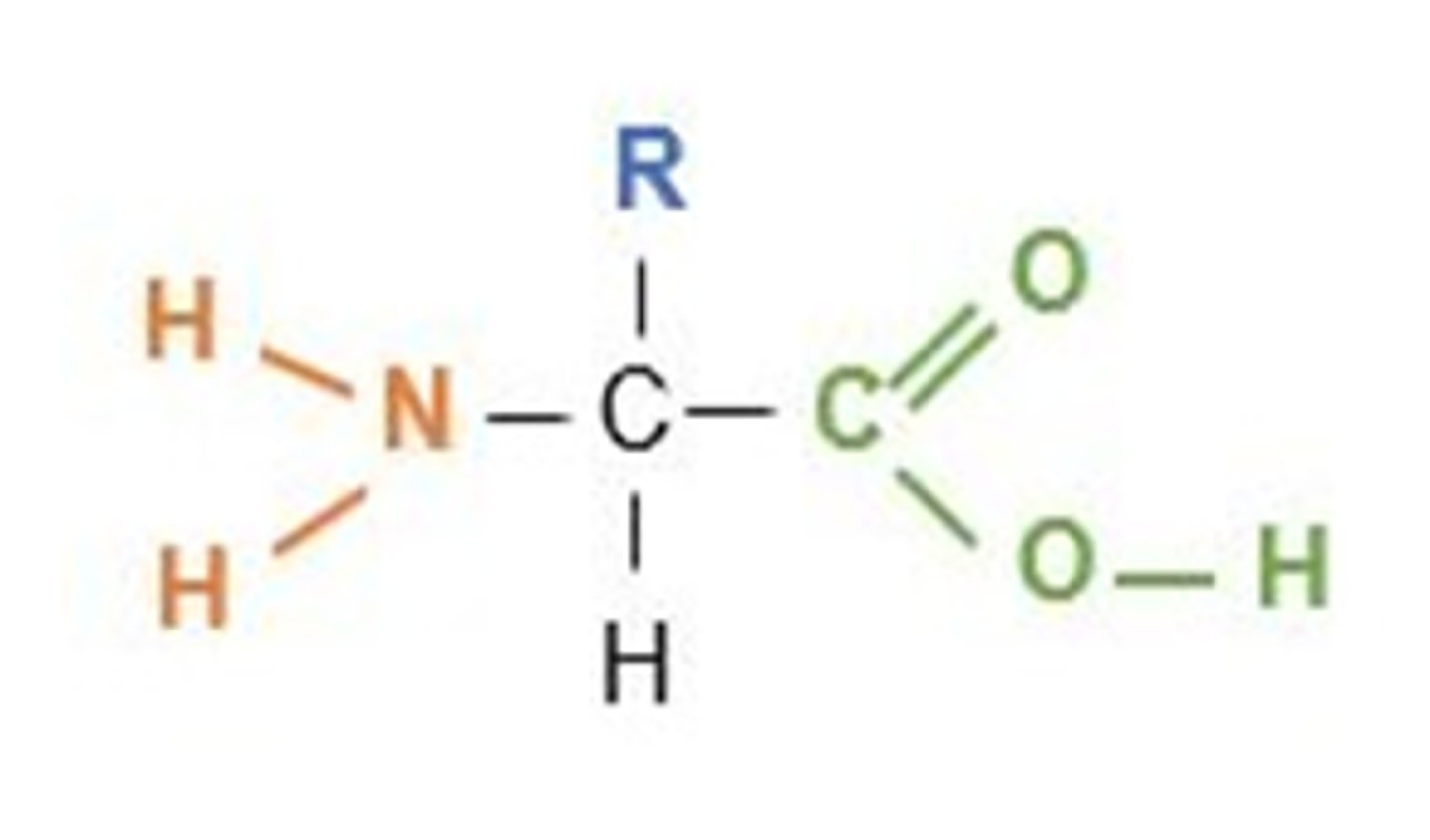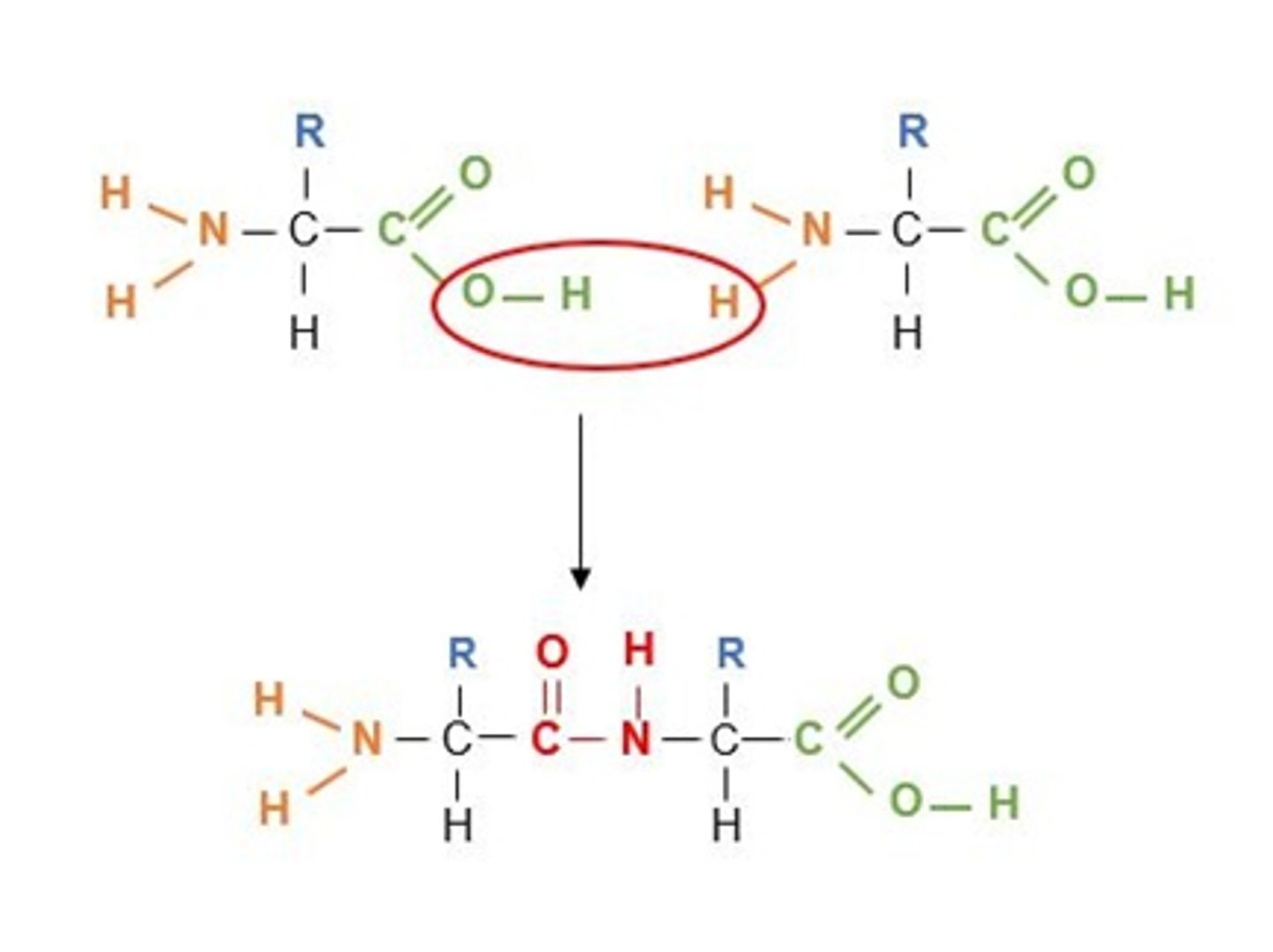Biological Molecules: Foundations in Biology: Biology OCR A Level
1/46
There's no tags or description
Looks like no tags are added yet.
Name | Mastery | Learn | Test | Matching | Spaced |
|---|
No study sessions yet.
47 Terms
How do hydrogen bonds form between water molecules?
Water is polar: O more electronegative than H, so attracts electron density in covalent bond more strongly. Forms O 𝛿- (slightly negative) & H 𝛿+ (slightly positive).
There are intermolecular forces of attraction between a lone pair on O 𝛿- of one molecule & H 𝛿+ on an adjacent molecule.
State 7 biologically important properties of water.
● reaches maximum density at 4℃
● high surface tension
● incompressible
● metabolite/ solvent for chemical reactions in the body
● high specific heat capacity
● high latent heat of vaporisation
● cohesion between molecules
Why is the incompressible nature of water important for organisms?
Provides turgidity to plant cells.
Provides hydrostatic skeleton for some small animals e.g. earthworms.
Explain why ice floats on water. Why is this important for organisms?
Ice is less dense than water because H-bonds hold molecules in fixed positions further away from each other.
Insulates water in arctic climates so aquatic organisms can survive. Water acts as a habitat.
Why is the high surface tension of water important for organisms?
Slows water loss due to transpiration in plants.
Water rises unusually high in narrow tubes, lowering demand on root pressure.
Some insects can ‘skim’ across the surface of water.
Why is water an important solvent for organisms?
Polar universal solvent dissolves & transports charged particles involved in intra & extracellular reactions e.g. PO4 3- for DNA synthesis.
Why are the high specific heat capacity and latent of vapourisation of water important for organisms?
Acts as a temperature buffer which enables endotherms to resist fluctuations in core temperature to maintain optimum enzyme activity.
Cooling effect when water evaporates from skin surface as sweat/ from mouth when panting.
Define monomer and polymer. Give some examples.
monomer: smaller units that join together to form larger molecules
● monosaccharides (glucose, fructose, galactose, ribose)
● amino acids
● nucleotides
polymer: molecules formed when many monomers join together
● polysaccharides
● proteins
● DNA/ RNA
What happens in condensation and hydrolysis reactions?
Condensation: chemical bond forms between 2 molecules & a molecule of water is produced.
Hydrolysis: a water molecule is used to break a chemical bond between 2 molecules e.g. peptide bonds in proteins, ester bonds between fatty acids & glycerol in lipids.
Name the elements found in carbohydrates, lipids, proteins and nucleic acids.
carbohydrates & lipids: C, H, O
proteins: C, H, O, N, S
nucleic acids: C, H, O, N, P
Draw the structure of ⍺-glucose and 𝛽-glucose.
both hexose monosaccharides (6C) with ring structure.

Describe the properties of 𝛼 glucose.
● Small & water soluble = easily transported in bloodstream.
● Complementary shape to antiport for co-transport for absorption in gut.
● Complementary shape to enzymes for glycolysis = respiratory substrate.
Draw the structure of ribose.
pentose monosaccharide (5C) ring structure.

What type of bond forms when monosaccharides react?
(1,4 or 1,6) glycosidic bond
● 2 monomers = 1 chemical bond = disaccharide.
● Multiple monomers = many chemical bonds = polysaccharide.
Name 3 disaccharides. Describe how they form.
Condensation reaction forms glycosidic bond between 2 monosaccharides.
● maltose: glucose + glucose
● sucrose: glucose + fructose
● lactose: glucose + galactose
all have molecular formula C12H22O11
Describe the structure and functions of starch.
Storage polymer of 𝛼-glucose in plant cells:
● insoluble = no osmotic effect on cells
● large = does not diffuse out of cells
made from amylose:
● 1,4 glycosidic bonds
● helix with intermolecular H-bonds = compact
and amylopectin:
● 1,4 & 1,6 glycosidic bonds
● branched = many terminal ends for hydrolysis into glucose
Describe the structure and functions of glycogen.
Main storage polymer of 𝛼-glucose in animal cells (but also found in plant cells):
● 1,4 & 1,6 glycosidic bonds.
● Branched = many terminal ends for hydrolysis.
● Insoluble = no osmotic effect & does not diffuse out of cells.
● Compact.
Describe the structure and functions of cellulose.
Polymer of 𝛽-glucose gives rigidity to plant cell walls (prevents bursting under turgor pressure, holds stem up).
● 1,4 glycosidic bonds.
● Straight-chain, unbranched molecule.
● Alternate glucose molecules are rotated 180°.
● H-bond crosslinks between parallel strands form microfibrils = high tensile strength.
How do triglycerides form?
Condensation reaction between 1 molecule of glycerol &
3 fatty acids which forms ester bonds.

Contrast saturated and unsaturated fatty acids.
Saturated:
● contain only single bonds
● straight-chain molecules have many contact points
● higher melting point = solid at room temperature
● found in animal fats
Unsaturated:
● contain C=C double bonds
● ‘kinked’ molecules have fewer contact points
● lower melting point = liquid at room temperature
● found in plant oils
Relate the structure of triglycerides to their functions.
● High energy:mass ratio = high calorific value from oxidation (energy storage).
● Insoluble hydrocarbon chain = no effect on water potential of cells & used for waterproofing.
● Slow conductor of heat = thermal insulation e.g. adipose tissue.
● Less dense than water = buoyancy of aquatic animals.
Describe the structure and function of phospholipids.
Amphipathic: glycerol backbone attached to 2 hydrophobic fatty acid tails & 1 hydrophilic polar
phosphate head.
● Forms phospholipid bilayer in water = component of membranes.
● Tails can splay outwards = waterproofing e.g. for skin.
Are phospholipids and triglycerides polymers?
No; they are not made from a small repeating unit. They are macromolecules.
Describe the structure and function of cholesterol.
Steroid structure of 4 hydrocarbon rings. Hydrocarbon tail on one side, hydroxyl group (-OH) on the other side.
Adds stability to cell surface phospholipid bilayer by connecting molecules & reducing fluidity.
What is the general structure of an amino acid?
-COOH carboxyl / carboxylic acid group.
-R variable side group consists of carbon chain & may include other functional groups e.g. benzene ring or -OH (alcohol).
-NH2 amine/ amino group.

How do polypeptides form?
Condensation reactions between amino acids form peptide bonds
(-CONH-).
There are 4 levels of protein structure.

Define ‘primary structure’ of a protein.
Primary: sequence, number & type of amino acids in the polypeptide, determined by sequence of codons on mRNA.
Secondary: hydrogen bonds form between O
𝛿- attached to ‒C=O & H 𝛿+ attached to ‒NH.
Describe the 2 types of secondary protein structure.
α-helix:
● All N-H bonds on same side of protein chain.
● Spiral shape.
● H-bonds parallel to helical axis.
β-pleated sheet:
● N-H & C=O groups alternate from one side to the other.
Define ‘tertiary structure’ of a protein. Describe the bonds present.
3D structure formed by further folding
● Disulfide bridges: strong covalent S-S bonds between molecules of the amino acid cysteine.
● Ionic bonds: relatively strong bonds between charged R groups (pH changes cause these bonds to break).
● Hydrogen bonds: numerous & easily broken.
Define ‘quaternary structure’ of a protein.
● Functional proteins may consist of more than one polypeptide.
● Precise 3D structure held together by the same types of bond as tertiary structure.
● May involve addition of prosthetic groups e.g metal ions or phosphate groups.
Describe the structure and function of globular proteins.
● Spherical & compact.
● Hydrophilic R groups face outwards & hydrophobic R groups face inwards = usually water-soluble.
● Involved in metabolic processes e.g. enzymes such as amylase, insulin (2 polypeptide chains linked by 2 disulfide bonds), haemoglobin.
Describe the structure of haemoglobin.
● Globular conjugated protein with prosthetic group.
● 2 𝛼-chains, 2 𝛽-chains, 4 prosthetic haem groups.
● Water-soluble so dissolves in plasma.
● Fe2+ haem group forms coordinate bond with O2.
● Tertiary structure changes so it is easier for subsequent O2 molecules to bind (cooperative binding).
Describe the structure and function of fibrous proteins.
● Can form long chains or fibres.
● Insoluble in water.
● Useful for structure and support e.g. collagen in skin.
List the functions of collagen, elastin and keratin.
Collagen: component of bones, cartilage, connective tissue, tendons.
Elastin: provides elasticity to connective tissue, arteries, skin, lungs, cartilage, ligaments.
Keratin: structural component of hair, nails, hooves/ claws, horns, epithelial cells of outer layer of skin.
Describe how to test for proteins in a sample.
Biuret test confirms presence of peptide bond
1. Add equal volume of sodium hydroxide to sample at room temperature.
2. Add drops of dilute copper (II) sulfate solution. Swirl to mix. (steps 1 & 2 make Biuret reagent).
3. Positive result: colour changes from blue to purple Negative result: solution remains blue.
Describe how to test for lipids in a sample.
1. Dissolve solid samples in ethanol.
2. Add an equal volume of water and shake.
3. Positive result: milky white emulsion
forms
Describe how to test for reducing sugars.
1. Add an equal volume of Benedict’s reagent to a sample.
2. Heat the mixture in an electric water bath at 100℃ for 5 mins.
3. Positive result: colour changes from blue to orange & brick-red precipitate forms.
Or use test strip coated in a reagent that changes colour if reducing sugar is present.
Describe the Benedict’s test for non-reducing sugars.
1. Negative result: Benedict’s reagent remains blue.
2. Hydrolyse non-reducing sugars e.g. sucrose into their monomers by adding 1cm3 of HCl. Heat in a boiling water bath for 5 mins.
3. Neutralise the mixture using sodium carbonate solution.
4. Proceed with the Benedict’s test as usual.
Describe the test for starch.
1. Add iodine solution.
2. Positive result: colour changes from orange to blue-black.
State the role and chemical symbol of nitrates and ammonium.
NO3- is used to make DNA, amino acids, NADP for photosynthesis & NAD for respiration.
NH4 + can be converted to NO3- by saprobionts during nitrogen cycle. Produced by deamination of amino acids during ornithine cycle in liver.
State the role and chemical symbol of hydroxide and phosphate ions.
OH- ions affect pH & can interact with bonds in 3° protein structure to cause denaturation.
PO4 3-is a component of ATP/ADP for energy release & NADP.
State the role and chemical symbol of sodium, potassium and chloride ions.
Na+ & K+ are involved in maintenance of resting potential of neurones/ generation of action potentials. Na+ is also involved in co-transport mechanisms.
Cl- is involved in inhibitory synapses to cause hyperpolarisation.
State the role and chemical symbol of hydrogen and hydrogencarbonate ions.
H+ & HCO3- form in organisms when CO2 dissolves in water.
H+ regulates pH & can interact with bonds in 3° protein structure to cause denaturation. H+ pump is involved in chemiosmosis & active loading in translocation.
State the role and chemical symbol of calcium ions.
Ca2+ is used to make calcium pectate to add stability to middle lamella of plant cell walls. Regulates exocytosis of neurotransmitter. Binds to troponin to stimulate muscle contraction.
How can the concentration of a solution be measured quantitatively?
● Use colorimetry to measure absorbance/%transmission. Interpolate a calibration curve from solutions of known concentration.
● Use biosensors. A bioreceptor detects the presence of a chemical. A transducer converts the response into a detectable electrical signal.
Outline the principles and process of paper/ thin-layer chromatography.
1. Use capillary tube to spot solution onto pencil ‘start line’ (origin) 1 cm above bottom of paper.
2. Place chromatography paper in solvent. (origin should be above solvent level).
3. Allow solvent to run until it almost touches other end of the paper. Molecules in mixture move different distances based on relative solubility in solvent/attraction to paper.
What are Rf values? How can they be calculated?
Ratios that allow comparison of how far molecules have moved in chromatograms.
Rf value = distance between origin and centre of pigment spot / distance between origin and solvent front.